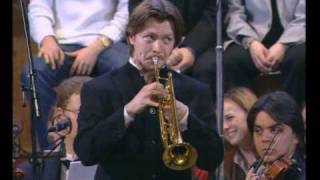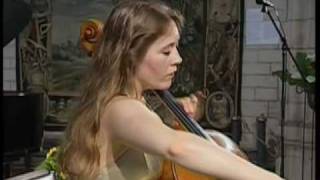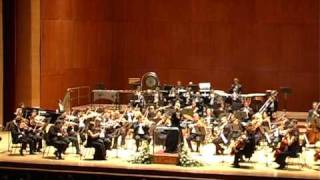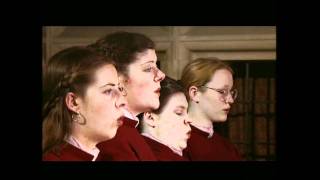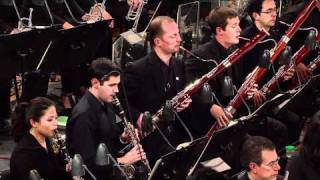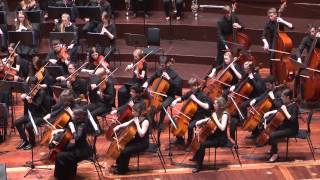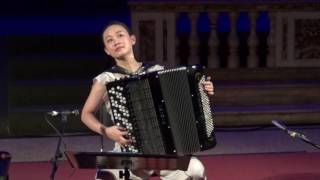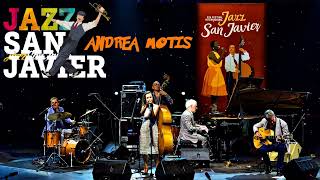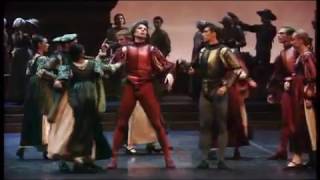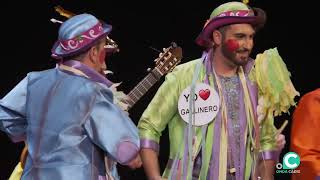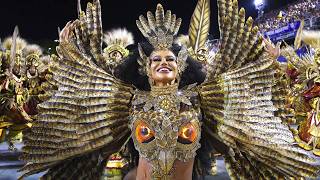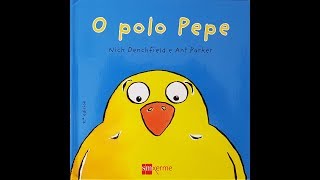Carnival Saturday is celebrated on February 10
On February 14, Valentine's Day is celebrated, the day of lovers.
Recommended music videos for initiation to classical music
The origin of Carnival seems to come from the festivals that were celebrated in the Roman Empire in honor of Bacchus , god of wine and celebration, to celebrate the arrival of spring. In Western culture, Carnival is associated with Catholicism, since Lent begins with Ash Wednesday , after which comes Holy Week ; days, all of them, of meditation and penance. In this way, knowing what is coming, the last day of the holiday is celebrated, Carnival Tuesday ; festival that begins the previous Thursday, called Lardero Thursday or Fat Thursday . The characteristic of these days basically consists of the celebration in the street of a festive and collective debauchery expressed in costumes, couplets, dances, parades and any occurrence that arises.
Jean Baptist Arban (1825 - 1889) was a French cornetist, conductor and pedagogue. He was influenced by the virtuoso violin technique of Niccolò Paganini and made an attempt to use the cornet as a true solo instrument. He was born in Lyon (France) on February 28, 1825. He studied trumpet with François Dauverné at the National Superior Conservatory of Music and Dance in Paris from 1841 to 1845. He was appointed professor of saxophone (instrumental family in which, among other instruments , the cornet, euphonium and tuba are grouped) at the Military School in 1857 and professor of cornet at the Paris Conservatory in 1869, where Merri Franquin was among his students. He published Grande méthode complète pour cornet à pistons et de saxhorn in Paris in 1864 and is still used by modern players.
His variations on the Venice Carnival theme, which we offer today, continue to be one of the references for modern cornet and trumpet soloists. Today we offer it in trumpet version with Sergei Nakariakov as soloist.
Jorge Cardoso (1949) is an Argentine concert pianist and composer of more than 400 works, most for guitar alone or accompanied; Transcriptions and arrangements from all periods and especially those referring to Latin American countries reach almost the same number. Subject of numerous and important awards, he is currently Senior Professor of Guitar at the Royal Conservatory of Madrid .
The Milonga is a River Plate folk musical genre, typical of Argentina, Uruguay and Rio Grande do Sul (Brazil); The genre comes from gaucho culture. It is performed in binary time, but often with guitar accompaniment in 6/8. It is presented in two modalities: on the one hand, the milonga campera , pampeana or surera (belonging to the so-called southern or southern music), which It is the original form of the milonga . On the other hand, the citizen milonga , a later musical style. His first recording was Un bailongo (1922), composed and written by the Afro-Argentine José Ricardo , sung by Carlos Gardel and its music performed by Guillermo Barbieri and José Ricardo himself. Nine years later, in 1931, Sebastián Piana composed Milonga sentimentala l, the first citizen milonga that was widely disseminated.
Tatyana Ryzhkova , our performer today, was born in 1986 in Belarus , and is one of the most promising classical guitarists today. On YouTube he has already made a place for himself in the header of classical guitarists. Behind him there are more than 500 concerts around the globe and his number of fans is constantly increasing, rewarding them with an intense staging, a mix of passion, virtuosity and peculiar entertainment. Along with the classical repertoire, Tatyana has developed as a singer-songwriter: her own melody, lyrics and voice converge wonderfully in a gift for the senses.
Franz Liszt (1811-1886) was a brilliant Hungarian pianist and composer, whose works have endured over the years; works for solo or concert piano, as well as orchestral works, among which his symphonic poems should be highlighted, the musical form of which he is the progenitor. Liszt 's father, an amateur musician, gave him his first piano lesson at the age of seven. In October and November 1820, at the age of nine, he appeared in concerts in Sopron and Bratislava . His father arranged for Franz to be presented to the Court of the House of Esterházy as a child prodigy. He was famous throughout Europe during the 19th century ; His contemporaries claimed that he was the most technically advanced pianist of his time and the greatest of all time.
Liebesträume (dream of love) is a set of three nocturnes written for piano by Franz Liszt (1811-1886), of which No. 3, which we suggest today, is the best known.
Today we offer it in a cello-piano version by the cellist Seeli Toivio accompanied by her brother, the pianist Kalle Toivio
Francis Lai (1932-2018) was a French composer who specialized in creating music for film soundtracks. Author of A Man and a Woman and Love Story , with which he won the Oscar for best film score in 1970. At a very early age he was fascinated by music, beginning to play in regional orchestras. In Marseille he discovered jazz and met Claude Goaty , whom he followed to Paris , frequenting the musical environments of Montmartre . There he would become Edith Piaf 's companion and also one of her composers. In 1965 he met filmmaker Claude Lelouch who hired him to help him write the film A Man and a Woman with which he won the Golden Globe award for "Best Original Score." From that moment on, his works and recognitions were multiple.
Inma Shara (Inmaculada Saratxaga: Amurrio, Araba, 1972) is a Basque orchestra conductor. He started playing music at the age of 4 and at 16 he opted for the baton as an instrument. He studied at the Bilbao Conservatory and the Vitoria Conservatory. He has conducted the most important Spanish symphony orchestras and has collaborated with some of the best orchestras in the world such as the London Philharmonic Orchestra, the Israel Philharmonic and the Czech, Russian, Rome, Taiwan, Milan, Lithuania, Ukraine , etc. symphonies. He also collaborates with soloists of the stature of Mischa Maisky, Boris Berezovsky or Shlomo Mintz , among others. She was named "Honorary Ambassador of the Spain Brand, for being "one of the most brilliant representatives of the new generation of orchestra conductors”
Recommended classical music videos
Gregorio Allegri (1582-1652) was an Italian priest, singer and composer; He began musically as a boy soprano in the church of San Luigi dei Francesi in Rome with the cappella maestro Giovanni Bernardino Nanino from 1591 to 1596, the year in which his voice changed. He studied music with Giovanni Maria Nanino , brother of Bernardino and friend of Giovanni Pierluigi da Palestrina . In 1629 he entered the Choir of the Papal Chapel , remaining there until his death; The position provided him with prestige and economic security. His work, mainly composed of sacred music, consists of numerous masses, motets, lamentations, magnificats, concertini for solo voice, etc. He also composed a four-part sonata for strings considered the prototype of the string quartet.
Miserere. His best-known creation is the music composed for the psalm Miserere mei Deus , made around 1638. Since then the work has been performed regularly during Holy Week in the Sistine Chapel . It is written for two choirs, one with four voices and the other with five. One of the choirs sings a simple version of the original theme and the other choir, at a distance, sings a more elaborate commentary. It is one of the best examples of the polyphonic style of the Renaissance , called in the 17th century stile antico or prima prattica , and denotes the combined influences of the Roman (Palestrina) and Venetian school (Andrea and Giovanni Gabrieli, the double chorus).
At first, a prohibition was imposed on executing the work outside the Sistine Chapel , and anyone who copied it was even threatened with excommunication, despite which some copies were made. In 1770 Wolfgang Amadeus Mozart , only 14 years old, after listening to it only once, transcribed the work on paper from memory and then made minor corrections on a second occasion. This event is generally remembered as an example of the genius of Mozart , who was even named Knight of the Order of the Golden Spur by the Pope when he learned of the event. Mozart 's copy, which reflected the improvisations, has not been preserved.
Today we offer it in interpretation of The Choir of Clare College of Cambridge conducted by its owner Timothy Brown .
Hector Berlioz (1803-1869) was a French composer, an eminent figure in programmatic music and romanticism in general. He studied in Paris and Rome , where he received a scholarship, focusing on the hymns of his teacher, Jean-François Lesueur , and imitating Beethoven a lot, then unknown in France ; also to Gluck, Mozart, Étienne Méhul and Carl Maria von Weber. In 1844 he composed the first known work for saxophone, the Canto Sagrado sextet, which was premiered under the baton of Berlioz himself and with Adolphe Sax on saxophone. He also wrote several symphonies (among which his best-known work, the Symphonie Fantastique, stands out), overtures, operas, cantatas, sacred music, non-theatrical dramatic works, choral works and numerous songs.
Overture is the instrumental introduction to an opera or other dramatic work, musical or not; although some independent instrumental compositions of the 19th and 20th centuries were also called overtures by their composers. The first operas dating from the beginning of the 17th century did not have overtures but did have an introduction made by the vocalists in which they summarized the action that was going to take place immediately afterwards. Instrumental introductions began to be commonly used in the mid- 17th century ; The German composer Christoph Willibald Gluck was one of the first to use material from his operas for overtures . In this way, these established the emotional profile of the opera that followed.
The overture The Roman Carnival , which we suggest today, is actually the prelude to act II of the opera Benvenuto Cellini ; opera that had a regrettable acceptance both in its debut and in the two subsequent performances that took place during the composer's lifetime; So he decided to present it as an independent work in 1844, achieving resounding success.
Today we offer it under the baton of Michael Tilson Thomas (1944), an important American pianist, composer and conductor.
Piotr Tchaikovsky (1840-1893) was a Russian composer who graduated from the Saint Petersburg Conservatory and wrote works of different genres, although where he achieved the greatest success was with his ballets. In 1859 he obtained a civil servant position in the Ministry of Justice , which he would leave after three years to be able to dedicate himself only to music. His personal life was plagued by continuous crises since the death of his mother and his repressed homosexuality, which forced him to enter into a marriage that only lasted a few months. He wrote more than 150 compositions, including works for piano, quartets, suites, symphonies, concertos, choirs, cantatas, operas and ballets. He died at the age of 53 and is considered one of the greatest composers in history.
Romeo and Juliet , the work that we offer today, is an “overture/fantasy”, as the author himself subtitles it, based on the work of the same name by William Shakespeare ; In it he portrays the moods of the characters who have to live between love and violence faced again and again until the theme of love appears languid and dying, announcing the suicide of the two protagonists.
Today we can see it in its interpretation by Sian Edwards (1959), an English director who began her career focused primarily on opera and was the first woman hired by the Royal Opera House , Covent Garden , to be invited again the following year. He has worked with many of the most important orchestras in the world such as the Los Angeles Philharmonic , the Berlin Symphony , the Frankfurt Radio Symphony , the Saint Petersburg Philharmonic , the London Sinfonietta , etc.
Martin Lohse was born in Copenhagen , where he began his education at the Institute of Musical Sciences , plus studies in rhetoric and mathematics as well as geology at the University of Copenhagen . In 1995 he was admitted to the Royal Danish Academy of Music in Copenhagen , where he studied composition and music theory as a student of Hans Abrahamsen and Niels Rosing-Schow . In 2004 he debuted at the Royal Academy of Music , where he also obtained a master's degree in music theory. He is currently an associate professor of music theory and head of the Department of Music Theory at the Royal Danish Academy of Music . His accordion works are regularly played at international competitions, community gatherings and festivals.
The accordion is a harmonic wind musical instrument, consisting of a bellows, a tuning fork and two wooden sound boxes. At both ends the bellows are closed by wooden boxes. The right-hand part of the accordion additionally has a fingerboard with an arrangement of keys that can be piano-like ( piano accordion ) or round keys (also called buttons ); The left hand part has buttons on both types of accordion for playing bass and accompaniment chords.
Recommended music videos for all tastes
Samba is a musical genre with African roots that emerged in Brazil , from which a type of dance is derived. It is one of the main manifestations of Brazilian popular culture and a symbol of national identity. (Not to be confused with Zamba , a completely different musical genre of Argentine origin). Although in some countries the female voice is used (the samba), in Brazil and in some countries such as Argentina and Uruguay , the male voice is used ( the samba ). It was in the ancient capital of Brazil where the dance of the freed slaves came into contact with other musical genres and incorporated them, acquiring a unique character. In this way, it was samba carioca that achieved the status of symbol of Brazilian national identity, spreading throughout Brazil , associated with Carnival .
Today we offer this collection of carnival musical works from Brazil .
Andrea Motis (Barcelona, May 9, 1995) is a Catalan trumpeter, saxophonist and jazz singer. He trained musically, starting at the age of 7, at the San Andrés Municipal Music School , a neighborhood in Barcelona , as a trumpeter first and a saxophonist later. In 2007, at only 12 years old, he began collaborating with the jazz group Sant Andreu Jazz Band . In 2010, when she was 15 years old, she recorded as a solo singer an album of jazz standards titled Joan Chamorro presents Andrea Motis . At the age of 20 he enrolled in the Higher School of Music of Catalonia (ESMUC) to pursue higher trumpet studies. Her album Emotional Dance marked the first time that the artist served as a composer as well as a performer.
Daniela Romo (1959), real name Teresa Presmanes Corona , is a Mexican singer, actress and presenter. At the age of eleven he joined a choir; He later studied theater at the Andrés Soler Academy and then traveled to Los Angeles to study singing. As a performer, Daniela recorded her first album in 1979. In 1983 she signed a contract with Hispavox to record her album Daniela Romo. In 1984 he participated in the Viña del Mar International Song Festival in Chile , having great success. In 1985 he participated in the World Popular Song Festival in Tokyo , representing Mexico . In 40 years as a singer she has recorded more than 20 albums and sold more than 18 million copies. She is the second most successful Mexican singer on the Billboard charts, only behind Ana Gabriel .
Ennio Morricone (1928-2020) was an Italian conductor and composer of more than 500 film and television soundtracks and other symphonic and choral compositions. With a musician father, as a child he began studying the trumpet and at the age of nine he entered the National Academy of Santa Cecilia . At the age of 18 he began writing for radio programs and, little by little, for film films. The film director Sergio Leone , a childhood friend, asked him to collaborate on his films and thus they created a different model of western, the Spagetti Western . His contracts expanded with other filmmakers until he became one of the most appreciated composers of soundtracks. Throughout his career he received important and countless awards endorsing his brilliant work.
Morricone Love : 1 (0´00´´) LA CALIFFA from “La califfa” .-. 2 (2´38´´) SI MUORE D'AMORE from “D'amore si muore” .-. 3 (6´27´´) I BAMBINI CI CHIEDONO PERCHÈ (TEMA) from “I figli chiedono perchè” .-. 4 (9´01´´) QUESTA SPECIE D'AMORE from “Questa specie d'amore” .-. 5 (11´36´´) NINNA NANNA PER ADULTERI from “Cuore di mamma” .-. 6 (14´41´´) INCONTRO from “Il maestro e Margherita” .-. 7 (18´58´´) LA RAGIONE, IL CUORE, L'AMORE from “Il diavolo nel cervello” .-. 8 (22´25´´) AMANTI D'OLTRETOMBA from “Amanti d'oltretomba” .-. 9 (24´46´´) UNA DONNA DA RICORDARE from “Maddalena” .-. 10 (29´05´´) LE DUE STAGIONI DELLA VITA from “Le due stagioni della vita” .-. 11 (32´46´´) MI VEDRAI TORNARE from “Mi vedrai tornare” .-. 12 (35´25´´) FORSE BASTA from “The turn of the world of Peynet's innamorati” .-. 13 (39´00´´) THING AVETE FATTO TO SOLANGE? from “Cosa avete fatto a Solange?” .-. 14 (41´39´´) NINNA NANNA IN BLU from “”Il gatto a new code” .-. 15 (44´17´´) A LIDIA (FINALE) from “Scusi, facciamo l'amore?” .-. 16 (47´37´´) VERUSCHKA from “Veruschka” .-. 17 (50´33´´) RITRATTO D'AUTORE from “La donna invisibile” .-. 18 (55´38´´) PER LE ANTICHE SCALE (PRELUDIO) from “Per le antiche scale” .-. 19 (59´06´´) PER AMORE from “Per amore” .-. 20 (63´06´´) VIAGGIO WITH ANITA from “Viaggio with Anita” .-. 21 (66´02´´) ROMANZA QUARTIERE from “Quartiere”
Recommended peculiar videos
Sergei Prokofiev (1891-1953) was a Soviet composer, pianist and conductor, considered one of the main composers of the 20th century and creator of numerous masterpieces in different musical genres. His works include such popular works as the march of The Love of the Three Oranges , the suite The Lieutenant Kijé , the ballet Romeo and Juliet , Peter and the Wolf ... Within the established forms and genres in which he worked, he created seven complete operas, seven symphonies, eight ballets, five piano concertos, two violin concertos, one cello concerto, and nine completed piano sonatas. After his death, Arthur Honegger proclaimed that Prokofiev "will remain for us the greatest figure in contemporary music."
Romeo and Juliet is a ballet based on the work of the same name by William Shakespeare and structured in three acts divided into thirteen scenes, including a prologue and epilogue. It is one of the composer's most appreciated works, based on the high melodic inspiration, the great rhythmic variety and the memorable character of the main themes. The difficulty of the score prevented the composer from enjoying the success that his piece would have years later; He was criticized for a lack of lyricism and symphonic nature, as was Tchaikovsky .
Today we offer the entire ballet in the Paris National Opera Ballet version.
Zuberoako Inauteria . The Zuberoa carnival (Xiberua or Xiberoa, Soule in French, is one of the seven territories that make up Euskal Herria) is known as The Masquerades of Zuberoa because originally the young singles were masked and disguised. s; After dividing into two groups, dances, verses, songs and theatrical shows emerged that revolved around some type of character; All these activities traveled throughout the territory until the last day of Carnival, Carnival Tuesday , in which they burned a doll, Zanpantzar .
The San Sebastian Basque dance group Argia Dantza Taldea is made up of about 45 members directed by Juan Antonio Urbeltz ; It has collected “in situ” abundant dances from the Basque Country grouped in cycles in which the authenticity of the choreographic, musical and instrumental versions, and even costumes, has taken precedence. At the 1968 Middlesbrough International Folklore Festival (England) he won first prize for dance among 28 groups from 22 nations. In 1998, the Alfred Toepfer Foundation in Hamburg awarded him the European Prize for Popular Art . In 2003 he presented the show Pas de Basque anchored in Basque tradition, but with a contemporary dynamic, to whose representation the video we present today belongs.
The chirigota is a carnival-style choral musical group that sings mainly in the streets offering humorous songs to the city. The songs performed by these choral groups are also generically called chirigotas . The chirigotas are recitative and monologue songs and have very simple musical forms from the pasodoble, the rumba, the tanguillo, the seguidilla, the jota, the isa canaria, etc. The ad-hoc invented lyrics are coupled with this music and deal with very diverse topics, focusing above all on current events, both political and the gossip press. In many carnivals, contests are held where groups compete for various prizes, mainly evaluating three aspects: the costumes or presentation, the quality of the voices and the acuity of the lyrics. The main objective of chirigota is to make the audience laugh through satirical-humorous criticism.
The Cádiz chirigota is composed of a maximum of 12 members and a minimum of 7, who perform the repertoire with at least two voices. The voice that chirigota usually uses is the tenor, which carries the melody. This voice is accompanied by second voices (descending third) and sometimes with basses. The chirigota is musically accompanied by a bass drum, a snare drum, two guitars and güiros. The repertoire performed by the chirigotas that participate in the Official Competition of Carnival Groups consists of a presentation (not necessarily with unpublished music) that is related to the type (costume) that that group wears, two pasodobles (with original music of the group) , two cuplés (with original music), a chorus (sung at the end of each cuplé and also original) that is related to the type of the group and a medley (divided into quatrains) that also refers to the type of burlesque form and humorous. In chirigota, unlike the comparsas and carnival choirs, what gives the group the most points are the two cuplés plus the chorus .
The Rio Carnival . Music, dance and parades of the Samba schools are manifestations that explode with all their splendor. The festival lasts four days in which it involves people of all ages and visitors who come from all over the world; four days in which the numerous samba schools of the city compete and which begins with the coronation of King Momo to whom the Prefect gives the keys to the city. The main event consists of the parade through the Sambadrome of the aforementioned samba schools ; although the party invades the most remote places of Rio . The video we present today reflects the parade held in 2020.
Recommended music videos for children
Various Wikipedia articles have been used to write these texts.
The texts of Videomusicalis are written in Basque, Spanish and English.





